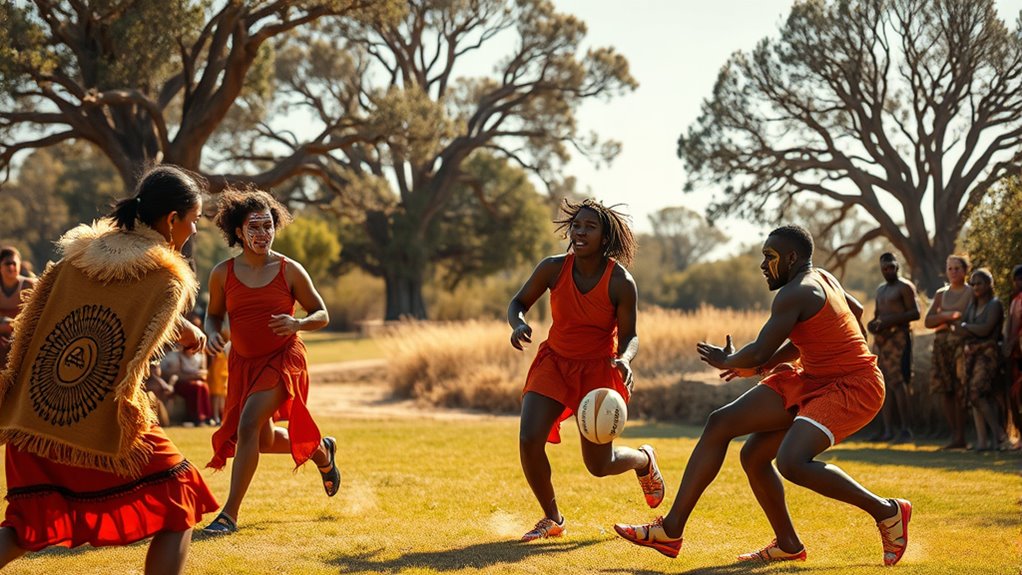Marngrook, a traditional Indigenous Australian game, played a key role in inspiring modern Australian football. It emphasized skills like kicking, teamwork, and agility, which remain central to the sport today. The game also reinforced cultural values such as respect and community spirit. By embracing these origins, you can see how modern football continues to carry the legacy of Marngrook. Keep exploring, and you’ll uncover more about how this ancient game shape today’s sports culture.
Key Takeaways
- Marngrook’s emphasis on kicking, marking, and teamwork directly influenced the skill set of modern Australian football.
- The fast-paced gameplay and aerial marks in AFL reflect traditional Marngrook techniques and strategies.
- Indigenous cultural values like fair play and respect are embedded in both Marngrook and contemporary Australian football.
- Marngrook served as a communal activity that fostered social bonds, inspiring the team spirit seen in modern AFL.
- Recognizing Marngrook’s role highlights indigenous contributions and roots of Australian football traditions.

Traditional games have been an essential part of cultures around the world, offering more than just entertainment. They carry deep cultural significance, often serving as a way to pass down stories, values, and social bonds from generation to generation. When you look at traditional Australian games, especially Marngrook, you’ll see how indigenous influence shapes not only the game itself but also the broader cultural landscape. Marngrook, played by Aboriginal peoples, is more than a sport; it’s a reflection of history, community, and identity.
Traditional Australian games like Marngrook embody indigenous culture, history, and community bonds beyond mere entertainment.
You might not realize it, but the roots of modern Australian football can be traced directly back to Marngrook. This game was played long before European settlers arrived, and it involved kicking a ball made from natural materials, often in teams, emphasizing skill, agility, and teamwork. The cultural significance of Marngrook lies in its role as a communal activity that reinforced social bonds and cultural values. It was more than a pastime—it was a way to celebrate survival, connection with the land, and respect for tradition. The indigenous influence on this game is evident in its emphasis on skills like kicking, marking, and strategic play, elements that are still central to modern Australian rules football today.
By understanding Marngrook, you gain insight into how indigenous communities used sport as a means of cultural expression and storytelling. This game was often performed during gatherings and ceremonies, reinforcing social cohesion and cultural identity. The emphasis on fair play, respect for opponents, and communal participation highlights the core values that have persisted into modern times. When you watch Australian football today, you can see echoes of Marngrook’s influence—especially in the fast-paced kicking, aerial marks, and team strategies. Recognizing this connection enriches your appreciation of the sport’s cultural depth and indigenous roots.
In essence, traditional games like Marngrook are crucial for understanding the cultural significance of indigenous influence in Australian history. They remind you that sports are more than just games—they are living expressions of culture, history, and community. Appreciating this helps you see Australian football not only as a popular sport but also as a continuation of a rich indigenous legacy. It’s a tribute to how traditional games serve as a bridge, linking past and present, and honoring the enduring spirit of indigenous communities in Australia.
Frequently Asked Questions
How Did Marngrook Influence Specific Rules in Modern Australian Football?
You can see how Marngrook influenced modern Australian football through its emphasis on ball movement and team strategies. The game’s fast-paced, kicking-centric style encourages players to pass and move quickly, mirroring Marngrook’s focus on teamwork and agility. These elements shaped rules like the free kick for high tackles and the emphasis on teamwork, making the game more dynamic and skillful, just like traditional Marngrook.
Are There Any Other Indigenous Games That Impacted Australian Sports?
You know what they say, “Every game has a story,” and indigenous ballgames like Bunjil and Wanggarri have profoundly impacted Australian sports. These traditional sports, rooted in Indigenous culture, introduced unique skills and gameplay elements that influenced modern rugby and cricket. By embracing these indigenous ballgames, you can see how traditional sports continue to shape and inspire contemporary Australian sporting culture.
When Did Marngrook First Start to Influence Mainstream Australian Sports?
You see, Marngrook began influencing mainstream Australian sports during the early 20th century through cultural exchange and recognition of Indigenous traditions. Its role in the sporting evolution became more apparent as players and officials acknowledged its impact on Australian rules football. By embracing these Indigenous roots, the sport evolved to reflect cultural diversity, inspiring modern gameplay and fostering greater appreciation for Indigenous contributions within the broader sporting community.
What Are the Key Similarities Between Marngrook and Australian Football?
You’ll notice key similarities between Marngrook and Australian football in their game mechanics and cultural significance. Both involve kicking and catching, emphasizing agility and skill. The games also hold deep cultural importance, celebrating Indigenous heritage and community. Marngrook’s influence is evident in Australian football’s emphasis on teamwork and sportsmanship, reflecting shared traditions and values. These parallels highlight how traditional games shape modern sports, blending history with contemporary gameplay.
How Is Marngrook Played Today in Indigenous Communities?
You see marngrook played passionately in indigenous communities, where it’s more than a game—it’s a vibrant celebration of culture. As kids chase the ball across open fields, the air fills with songs and stories, strengthening community bonds. This traditional game holds deep cultural significance, fostering pride and continuity. You feel the energy and history in every kick, making marngrook a crucial part of indigenous life today.
Conclusion
Just like a river shaping the land over time, Marngrook carved its way into the heart of modern Australian football. By understanding this ancient game, you see how tradition flows into today’s sport, bridging past and present. It’s a reminder that games aren’t just play; they’re stories etched in history, waiting to inspire. So, next time you watch a game, remember—you’re part of a legacy that’s as old as the land itself.
Mary is a passionate writer who brings creativity and a fresh perspective to our team. Her words have the power to captivate and inspire, making her an essential contributor to our content. Mary’s commitment to storytelling and dedication to promoting Indigenous culture ensures that her work touches the hearts of our readers. We’re fortunate to have her as part of our team.










